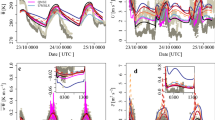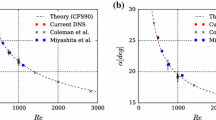Abstract
The evolution of the boundary layer on day 33 of the Wangara experiment in southeast Australia is calculated with a higher-order-closure turbulence model. This model, which includes equations for the mean field as well as the second moments of the turbulent field, is described in detail. The mean profiles of wind, temperature, and humidity, the profiles of heat and humidity fluxes, the Reynolds stress distributions, and the height of the boundary layer are shown between 10 a.m. and 6 p.m. The results agree well with those from Deardorff's 3-D simulation and take relatively little computer time.
Similar content being viewed by others
References
Bradshaw, P.: 1972, The Understanding and Prediction of Turbulent Flow, Aero. J. 76, 403–418.
Bradshaw, P.: 1973, The Strategy of Calculation Methods for Complex Turbulent Flows, I.C. Aero Report 73–05, Dept. of Aeronautics, Imperial College, London, 56 pp.
Busch, N. E.: 1973, On the Mechanics of Atmospheric Turbulence, in D. A. Haugen (ed.), Workshop on Micrometeorology, Am. Meteorol. Soc., Boston, pp. 1–65.
Businger, J. A., Wyngaard, J. C., Izumi, Y., and Bradley, E. F.: 1971, Flux-Profile Relationships in the Atmospheric Surface Layer, J. Atmospheric Sci. 28, 181–189.
Clarke, R. H., Dyer, A. J., Brook, R. R., Reid, D. G., and Troup, A. J.: 1971, The Wangara Experiment: Boundary Layer Data, Paper No. 19, Div. of Meteorol. Physics, CSIRO, Australia.
Deardorff, J. W.: 1972, Numerical Investigation of Neutral and Unstable Planetary Boundary Layers, J. Atmospheric Sci. 29, 91–115.
Deardorff, J. W.: 1973, An Explanation of Anomalously Large Reynolds Stresses Within the Convective Planetary Boundary Layer, J. Atmospheric Sci. 30, 1070–1076.
Deardorff, J. W.: 1974a, Three-Dimensional Numerical Study of the Height and Mean Structure of a Heated Planetary Boundary Layer, Boundary-Layer Meteorol. 7, 81–106.
Deardorff, J. W.: 1974b, Three-Dimensional Numerical Study of Turbulence in an Entraining Mixed Layer, Boundary-Layer Meteorol. 7, 199–226.
Donaldson, C. DuP.: 1973, Construction of a Dynamic Model of the Production of Atmospheric Turbulence and the Dispersal of Atmospheric Pollutants, in D. A. Haugen, (ed.), Workshop on Micrometeorology, Am. Meteorol. Soc., Boston, pp. 313–392.
Dufort, E. C. and Frankel, S. P.: 1953, Stability Conditions in the Numerical Treatment of Parabolic Differential Equations, Math Tables Aids Comput. 7, 135–152.
Lumley, J. L. and Khajeh-Nouri, B.: 1974, Computational Modeling of Turbulent Transport, Adv. Geophys. 18A, 169–192.
Lumley, J. L. and Panofsky, H. A.: 1964, The Structure of Atmospheric Turbulence, Interscience Publ., New York.
Pennell, W. T. and LeMone, M. A.: 1974, An Experimental Study of Turbulence Structure in the Fair Weather Trade Wind Boundary Layer, J. Atmospheric Sci. 31, 1308–1323.
Readings, C. J., Haugen, D. A., and Kaimal, J. C.: 1974, The 1973 Minnesota Boundary-Layer Study, Weather 29, 309–312.
Reynolds, W. C.: 1970, Computation of Turbulent Flows - State-of-the-Art, 1970, Report MD-27, Dept. of Mech. Eng., Stanford Univ., Stanford, Cal.
Tennekes, H. and Lumley, J. L.: 1972, A First Course in Turbulence, Cambridge, MIT Press.
Willis, G. E. and Deardorff, J. W.: 1974, A Laboratory Model of the Unstable Planetary Boundary Layer, J. Atmospheric Sci. 31, 1297–1307.
Wyngaard, J. C.: 1973, On Surface Layer Turbulence, in D. A. Haugen (ed.), Workshop on Micrometeorology, Am. Meteorol. Soc., Boston pp. 101–149.
Wyngaard, J. C., Coté, O. R., and Izumi, Y.: 1971, Local Free Convection, Similarity, and the Budgets of Shear Stress and Heat Flux, J. Atmospheric Sci. 28, 1171–1182.
Wyngaard, J. C., Arya, S. P. S., and Coté, O. R.: 1974a, Some Aspects of the Structure of Convective Planetary Boundary Layers, J. Atmospheric Sci. 31, 747–754.
Wyngaard, J. C., Coté, O. R., and Rao, K. S.: 1974b, Modeling the Atmospheric Boundary Layer, Adv. Geophys. 18A, 193–212.
Author information
Authors and Affiliations
Rights and permissions
About this article
Cite this article
Wyngaard, J.C., Coté, O.R. The evolution of a convective planetary boundary layer — A higher-order-closure model study. Boundary-Layer Meteorol 7, 289–308 (1974). https://doi.org/10.1007/BF00240833
Received:
Issue Date:
DOI: https://doi.org/10.1007/BF00240833




